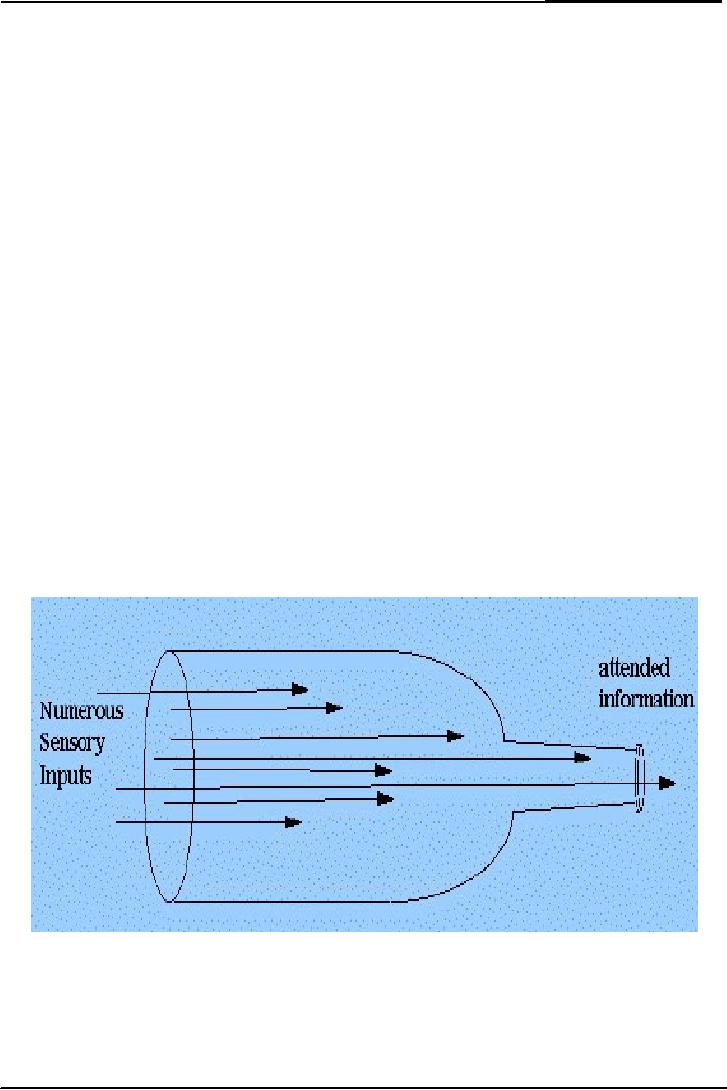 |

Cognitive
Psychology PSY 504
VU
Lesson
07
ATTENTION
Attention is a
perfect example of a cognitive
psychology area. Philosophers
and Scientific
Experimenters
unite again to unravel
attention. Philosophers theorize
and scientists
experiment
to
reach the same goal.
Computer scientists help us
with simulation e.g., a
camera attached with
computer.
Cognitive psychologists also
work with computer
scientists for making
simulations,
although
this is not their primary
job.
From
Sensory Memory most of the
information is discarded. Some of it is
selected for further
processing.
Attention plays a crucial
role in this stage of
selection of information.
What
is attention?
Attention
is conceived of as being a very
limited mental resource.
Numerous metaphors can
help
us
to think about the
limited-resource characteristics of
attention.
Some
common metaphors;
Is
it a spotlight? A beam? (On
stage)
One
person is standing on stage
and the beam light is
just fallen on him not on
whole stage.
Is
it a filter? A sieve (dirt is
thrown, flour)
Like
you are standing in a party
you just listen those
people in which u r standing.guest
tunes in
to
one message and filters
out others.
Is
it a bottleneck? a narrow lane?
(not enough liquid, traffic
can flow)
Attention:
A bottleneck?
This
figure is showing just
attended information comes
out.
Is
it a limited resource? (petrol,
manpower etc.)
Like
skilled manpower. Countries
have a lot of manpower but
highly educated people are
few.
Limited
metaphors are;
19

Cognitive
Psychology PSY 504
VU
Energy:
We use electricity according to
its capacity. If attention is
powered by a fixed
electrical
current. Given the fixed
energy supply, attention
would be allocable to only
so
many
tasks. If allocated to more,
the performance would
degrade or a fuse would
blow.
Spatial
or workspace: in workspace only so
many tasks can be performed.
Like hundred
employees
are not fitten in a small
room. We fit few people in
small room.
Demons:
attention as a small set of
agents like demons, that
can perform tasks but
only
one
at a time.
Single-mindedness
Attention
is single-minded sense so it is not
double-minded sense. In terms of
metaphors,
this
single-mindedness would mean
that only enough energy,
only enough workspace, or
only a
single
attention demon was
available for one task or
process. So it means one
thing at a time.
Attention
is a demanding task. It has a
capacity to perform only one
demanding task.
Attention
can't
perform two demanding tasks
simultaneously.
But
what about walking and
talking? Driving and
talking, and smoking?
Because tasks that
are
practiced
to the point at which they
do not make excessive
demands can be
performed
simultaneously.
We cannot simultaneously do mental
addition and carry on a
conversation is that
each
activity in itself involves
multiple attention-demanding
subcomponents. So it is clear
that
whether
or not attention is truly
single-minded, its capacity is
severely limited.
Limitations
in sensory tasks
The
limited capacity of attention is
the root cause of the
reporting limitations demonstrated
in
visual
and auditory reporting
tasks. Attention appears to be
the real reason for
whole report
performance.
Limitations of the icon and
echo are actually the
limitations of attention. All
the
information
gets into sensory memory,
but to be retained, each
unit of information must
be
attended
to and transformed into some
more permanent form. Sensory
information needs to be
stored
in a form that can be
retained. Selection for this
transformation happens only to
attended
items.
Most information is lost
because attention has
limited capacity.
Dichotic
Listening Tasks
Cherry
(1953); Moray (1959)
conducted an experiment on how
subjects select what sensory
input
they
attend to. This experiment
has involved a dichotic
listening task.
In
dichotic listening experiment
subjects wear a set of
headphones. They hear two
messages,
one
ear presented with one
message, the other ear
with another message.
Subjects pay
attention
to
(shadow) one message and
tune out the other.
Psychologist discovered that
very little about
the
unattended message is processed in a
shadowing task. Subjects
cannot tell what
language
was
spoken or report any of the
words spoken even if the
same word was repeated
over and over
again.
Subjects reported hearing
very little from the
other ear
In
Shadowing Paradigm
The
messages come in Left Ear
are: ran, house, Ox,
Cat....
In
Right Ear the messages
come are: Tea, job,
books, look....
People
are asked to attend to left
ear. Then they report
the messages that came
from left ear:
ran
house,
Ox, Cat. And they report
nothing from the
left
Early
Selection Model
Early
selection means information is
selected early, soon after
the sensory store. It
happens
early
on in this system. Higher
level processing is not
done. The meanings of the
words do
not
have an impact at this stage
in this model. The attention
must be itself is a lower
level
process.
20

Cognitive
Psychology PSY 504
VU
Early
Selection Model
The
figure is showing that
information is coming from
right and left ears.
But before going to
bottom
line information from one
ear is blocking other ear's
information. So according to
this
figure
attention is early selection
process and low level
process.
Attention
and meaning
Two
undergraduates at Oxford, Gray
and Wedderburn (1960),
conducted an experiment.
And
they demonstrated that
subjects were quite
successful in following a message
that jumped
back
and forth between
ears.
Shadow
meaningful messages that
were given to the subjects
were;
Left
Ear: John Eleven
books
Right
Ear: Eight writes
Twenty
Instructed
to shadow the meaningful
message, subjects reported:
John writes books.
Thus,
subjects
are capable of shadowing a
message on the basis of
meaning rather than physical
ear.
21
Table of Contents:
- INTRODUCTION:Historical Background
- THE INFORMATION PROCESSING APPROACH
- COGNITIVE NEUROPSYCHOLOGY:Brains of Dead People, The Neuron
- COGNITIVE NEUROPSYCHOLOGY (CONTINUED):The Eye, The visual pathway
- COGNITIVE PSYCHOLOGY (CONTINUED):Hubel & Wiesel, Sensory Memory
- VISUAL SENSORY MEMORY EXPERIMENTS (CONTINUED):Psychological Time
- ATTENTION:Single-mindedness, In Shadowing Paradigm, Attention and meaning
- ATTENTION (continued):Implications, Treisman’s Model, Norman’s Model
- ATTENTION (continued):Capacity Models, Arousal, Multimode Theory
- ATTENTION:Subsidiary Task, Capacity Theory, Reaction Time & Accuracy, Implications
- RECAP OF LAST LESSONS:AUTOMATICITY, Automatic Processing
- AUTOMATICITY (continued):Experiment, Implications, Task interference
- AUTOMATICITY (continued):Predicting flight performance, Thought suppression
- PATTERN RECOGNITION:Template Matching Models, Human flexibility
- PATTERN RECOGNITION:Implications, Phonemes, Voicing, Place of articulation
- PATTERN RECOGNITION (continued):Adaptation paradigm
- PATTERN RECOGNITION (continued):Gestalt Theory of Perception
- PATTERN RECOGNITION (continued):Queen Elizabeth’s vase, Palmer (1977)
- OBJECT PERCEPTION (continued):Segmentation, Recognition of object
- ATTENTION & PATTERN RECOGNITION:Word Superiority Effect
- PATTERN RECOGNITION (CONTINUED):Neural Networks, Patterns of connections
- PATTERN RECOGNITION (CONTINUED):Effects of Sentence Context
- MEMORY:Short Term Working Memory, Atkinson & Shiffrin Model
- MEMORY:Rate of forgetting, Size of memory set
- Memory:Activation in a network, Magic number 7, Chunking
- Memory:Chunking, Individual differences in chunking
- MEMORY:THE NATURE OF FORGETTING, Release from PI, Central Executive
- Memory:Atkinson & Shiffrin Model, Long Term Memory, Different kinds of LTM
- Memory:Spread of Activation, Associative Priming, Implications, More Priming
- Memory:Interference, The Critical Assumption, Limited capacity
- Memory:Interference, Historical Memories, Recall versus Recognition
- Memory:Are forgotten memories lost forever?
- Memory:Recognition of lost memories, Representation of knowledge
- Memory:Benefits of Categorization, Levels of Categories
- Memory:Prototype, Rosch and Colleagues, Experiments of Stephen Read
- Memory:Schema Theory, A European Solution, Generalization hierarchies
- Memory:Superset Schemas, Part hierarchy, Slots Have More Schemas
- MEMORY:Representation of knowledge (continued), Memory for stories
- Memory:Representation of knowledge, PQ4R Method, Elaboration
- Memory:Study Methods, Analyze Story Structure, Use Multiple Modalities
- Memory:Mental Imagery, More evidence, Kosslyn yet again, Image Comparison
- Mental Imagery:Eidetic Imagery, Eidetic Psychotherapy, Hot and cold imagery
- Language and thought:Productivity & Regularity, Linguistic Intuition
- Cognitive development:Assimilation, Accommodation, Stage Theory
- Cognitive Development:Gender Identity, Learning Mathematics, Sensory Memory